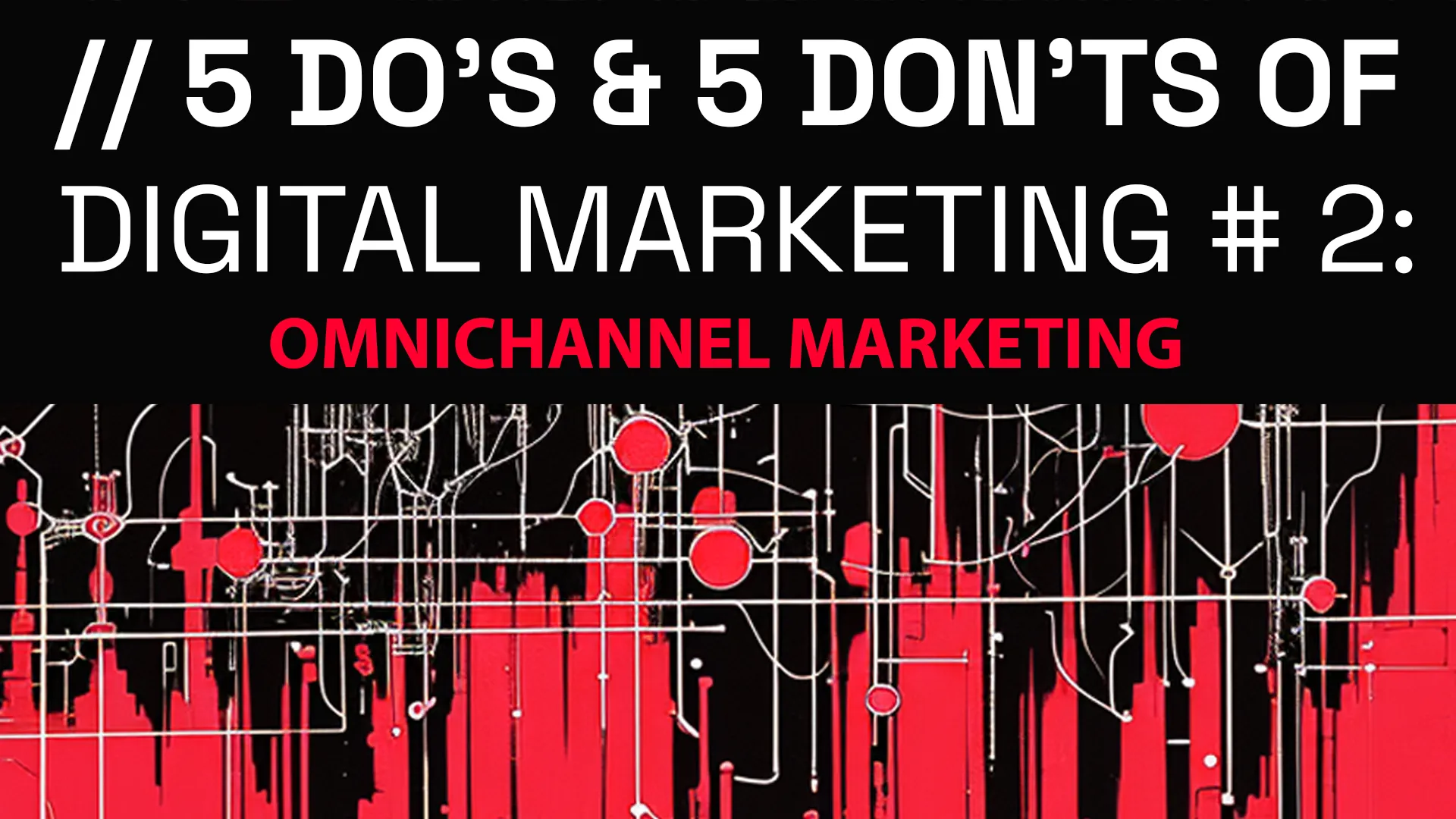
// THE 5 DO'S & 5 DON'TS OF DIGITAL MARKETING #2: OMNICHANNEL STRATEGY DEVELOPMENT
In the ever-evolving landscape of digital marketing, developing a robust omnichannel marketing strategy is crucial for connecting with your audience across various platforms.
A significant trend we’re observing in 2024 is the growing number of brands investing in an omnichannel approach, recognizing its critical role in achieving your business goals this year.
However, with so many channels available and constantly changing consumer behaviors, it can be challenging to know where to start or what pitfalls to avoid.
In this blog post, we’ll explore the 5 key do’s and don’ts of omnichannel strategy development. From selecting the right channels to leveraging the power of data, these tips are designed to help you build a cohesive, effective, and responsive marketing strategy that resonates with your audience and drives business results.
// 5 DO'S FOR OMNICHANNEL STRATEGY DEVELOPMENT
#1) Pick 3-5 Channels You Can Manage:
Enhance your brand’s impact by carefully choosing channels that not only align with where your audience is most active but also fit your company’s operational capabilities.
Conduct a realistic assessment of your team’s capacity — considering time, resources, and expertise — to identify a sustainable number of platforms for consistent and effective engagement.
Give priority to those channels where your target audience is most engaged, ensuring that your content not only reaches them but also strikes a chord.
This strategic approach guarantees that your efforts are not only widespread but also impactful, fostering a stronger and more meaningful connection with your audience.

#2) Provide Valuable and Relevant Content:
Whether it’s through blog posts, videos, podcasts, or infographics, ensure your content consistently delivers genuine value tailored to your audience’s interests and needs. This means crafting material that is not only educational and entertaining but also resonant with your audience’s current challenges and aspirations.
It’s about creating content that not only informs but also inspires, engaging them in a meaningful way. This could involve providing insightful industry analysis, actionable tips, personal stories that echo their experiences, or interactive elements that foster a deeper connection.
Remember, the key to effective content in an omnichannel strategy is its ability to empathize with and enrich your audience’s journey at every touchpoint.

#3) Leverage Tools for More Efficiency:
Managing posts across multiple channels can quickly become overwhelming, particularly when handled manually.
To streamline this process, consider leveraging automation tools that significantly reduce time and effort. Tools like Buffer and the Social Media Post Schedule feature in MailChimp allow for efficient post scheduling, ensuring your content is published consistently across all platforms.
Additionally, integrating AI tools like ChatGPT in your content strategy can be a game-changer. ChatGPT can assist in generating fresh content ideas, creating initial content drafts, and even suggesting improvements to existing content.
This not only saves time but also injects creativity and innovation into your content creation process, keeping it fresh and engaging.
#4) Have Consistent Messaging & Diverse Content:
Maintain a consistent core message across all platforms, but fine-tune it to align with each platform’s unique characteristics and audience behaviors.
Instagram users favor casual, visually engaging content, with users seeking entertainment over promotional offers. In contrast, Google Ads can be an effective platform for direct offers, catering to users with intent to purchase.
Understanding why your audience frequents a specific channel is crucial.
For example, many users turn to social media for entertainment, so receiving overt promotions in their newsfeed can feel intrusive. Therefore, platforms like TikTok and Instagram offer an excellent opportunity to showcase your brand’s personality and engage with your audience in a more relaxed, authentic manner.
This approach not only respects user preferences but also helps in building a more genuine connection with your audience.
#5) Stay Up-to-Date:
The digital marketing landscape is in a state of rapid and continual evolution. Some industry experts assert that the field has undergone more transformation in the past three years than in its entire previous history.
In this fast-paced environment, it’s crucial to remain abreast of the latest trends, understand the nuances of ever-changing algorithms, and keep a close eye on shifts in consumer behavior.
Being flexible and proactive isn’t just about staying relevant; it’s about actively engaging your audience with strategies that resonate in real-time.
This approach not only ensures effective engagement but also positions you to capitalize on opportunities that competitors who are slower to adapt might overlook.
// 5 DON'TS FOR OMNICHANNEL STRATEGY DEVELOPMENT
#1) Don’t Spam or Over-Communicate:
Striking the right balance between consistency and out-right spam is crucial. It’s important to avoid overwhelming your audience with excessive content. This approach can lead to diminishing returns as audiences become desensitized or perceive your brand as intrusive.
Instead, focus on crafting a well-balanced content strategy that values your audience’s time and attention, prioritizing high-quality content while maintaining a steady presence.
This means not only posting regularly but also ensuring that your content is relevant, timely, and adds value to the user experience.
Integrating audience feedback and analytics into your strategy can help you understand the impact of your content and refine your approach over time.

#2) Not Leveraging Short-Form Video Content:
Short-form video content is a mainstay in today’s market. Just look at 2023: brands big and small invested in short-form video content, and it’s not slowing down.
You don’t need a fancy setup to start. Good lighting and your smartphone are enough. Keep it simple and start with what you’ve got. Focus on the messaging and build from there.
The idea is to try, learn quickly, and keep tweaking your approach. This way, you stay fresh, relevant, and connected with your audience, without getting bogged down by overproduction
#3) Rely Solely on Past Triumphs:
The internet is always in fast-forward, and what was trending yesterday might be old news today.
Sticking to your core message is key, but don’t get stuck in yesterday’s success. Relying solely on past strategies can quickly lead to irrelevance. Why? Because your audience evolves, and so do their expectations.
Keep your core messaging consistent, but spice it up by tying in the latest trends or hot topics.
It’s about striking balance – staying true to your brand while riding the wave of current events.
This approach keeps your content fresh and your audience engaged, ensuring you stay relevant and on-point in a rapidly changing landscape.

#4) Adopt a One-Size-Fits-All Approach:
Customizing your messaging and creative approaches for various audience segments isn’t just a nice-to-have; it’s essential.
Personalization in marketing isn’t just a buzzword – it’s a proven strategy that nurtures both engagement and ultimately conversion rates.
By understanding and addressing the unique preferences and needs of different segments, you can craft messages that resonate more deeply with each group.
This targeted approach not only makes your audience feel seen and understood but also significantly enhances the effectiveness of your marketing efforts.
In a crowded markets, personalized marketing can be the key differentiator that sets your brand apart, driving more meaningful interactions and ultimately, better business results.

#5) Diminish Data’s Role:
Data is the cornerstone of informed decision-making.
Leveraging analytics goes beyond mere number crunching; it’s about gaining deep insights into customer behavior, evaluating campaign performance, and keeping a pulse on market trends.
When you base your strategies on solid data, you’re not just shooting in the dark. Instead, you’re making calculated decisions that are both focused and efficient.
A data-driven approach ensures that every marketing move is backed by evidence, significantly increasing the likelihood of success.
By understanding the story behind the numbers, you can tailor your strategies and content to be more responsive to the market’s needs, leading to more effective and impactful outcomes.
// CONCLUSION
Navigating the intricacies of omnichannel strategy development is no small feat.
As we’ve discussed, it’s a delicate balance of choosing the right channels, providing valuable content, leveraging efficient tools, maintaining consistent messaging with diverse content, and staying up-to-date.
Equally important is avoiding common missteps like over-communication, underutilizing short-form video content, relying solely on past successes, adopting a one-size-fits-all approach, and diminishing the role of data.
By integrating these do’s and don’ts into your strategy, you can create a more dynamic, engaging, and successful omnichannel presence that not only meets but exceeds the evolving expectations of your audience.
Remember, the key to a successful omnichannel strategy lies in your ability to adapt, personalize, and continually refine your approach based on both data and customer feedback.


